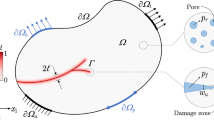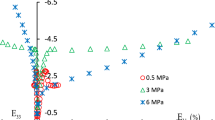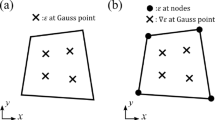Abstract
This article continues the work on dipolar thermoelastic materials, which are a special case of multipolar continuum mechanics. This theory allows a double-porous structure: a macro-porosity related to pores in the material and a microporosity, which shows fissures in the porous skeleton. This paper constructs a mathematical model for dipolar materials, which have a double-porosity structure by considering a fractional order Duhamel–Neumann stress–strain relation. The heat conduction is described by Cattaneo’s equations. The results are the constitutive equations of the linear theory of thermoelasticity with fractional order strain. The equations are valid for anisotropic materials and are called the Duhamel–Neumann equations with fractional order. Finally, the isotropic case is considered under the conditions of plane strain in order to perform some numerical simulations for samples of porous copper.


Similar content being viewed by others
References
Atangana A, Baleanu D (2017) Application of fixed point theorem for stability analysis of a nonlinear Schrödinger with Caputo–Liouville derivative. Filomat 31(8):2243–2248. https://www.doi.org/10.1117/12.323295
Berryman JG, Wang HF (1998) Double-porosity modeling in elastic wave propagation for reservoir characterization. In: Proceedings of mathematical methods in geophysical imaging V, vol. 3453. https://doi.org/10.1117/12.323295
Bhatti MM, Rashidi MM (2016) Effects of thermo-diffusion and thermal radiation on Williamson nanofluid over a porous shrinking/stretching sheet. J Mol Liq 221:567–573
Chirilă A (2017) Generalized micropolar thermoelasticity with fractional order strain. Bull Transilvania Univ Braşov Ser III: Math Inf Phys 10(1):83–90
Chirilă A, Agarwal RP, Marin M (2017) Proving uniqueness for the solution of the problem of homogeneous and anisotropic micropolar thermoelasticity. Bound Value Probl 2017:3. https://doi.org/10.1186/s13661-016-0734-0
Ciarletta M, Ieşan D (1993) Non-classical elastic solids, Pitman research notes in mathematics series. Longman Scientific and Technical, London
Cosserat E, Cosserat F (1909) Sur la théorie des corps deformables. Dunod, Paris
Eringen AC (1999) Microcontinuum field theories, I. Foundations and solids. Springer, New York
Green AE (1965) Micro-materials and multipolar continuum mechanics. Int J Eng Sci 3:533–537
Green AE, Rivlin RS (1965) Multipolar continuum mechanics: functional theory I. Proc R Soc Lond A 284:303–324. https://doi.org/10.1098/rspa.1965.0065
Grote MJ, Mitkova T (2012) Explicit local time-stepping methods for time-dependent wave propagation. arXiv:1205.0654v2:1-32
Hetnarski RB (1996) Thermal stresses IV. Elsevier, Amsterdam
Hilfer R (2000) Applications of fractional calculus in physics. World Scientific, Singapore
Ieşan D (1980) Mecanica generalizată a solidelor. Universitatea “Al. I. Cuza”, Centrul de multiplicare, Iaşi
Jiang C, Davey K, Prosser R (2017) A tessellated continuum approach to thermal analysis: discontinuity networks. Contin Mech Thermodyn 29:145–186
Kilbas AA, Marichev OI, Samko SG (1993) Fractional integrals and derivatives (theory and applications). Gordon & Breach, Switzerland
Kong Q, Feng W, Zhu X, Sun C, Ma J, Wang X (2017) Fabrication and characterization of bulk nanoporous Cu with hierachical pore structure. J Mater Sci 52:12445–12454. https://doi.org/10.1007/s10853-017-1356-3
Kumar R, Vohra R (2015) State space approach to plane deformation in elastic material with double porosity. Mater Phys Mech 24:9–17
Marin M (1997) On weak solutions in elasticity of dipolar bodies with voids. J Comput Appl Math 82(1–2):291–297
Marin M, Ellahi R, Chirilă A (2017) On solutions of Saint-Venant’s problem for elastic dipolar bodies with voids. Carpathian J Math 33(2):199–212
Marin M (2010) Harmonic vibrations in thermoelasticity of microstretch materials. J Vib Acoust ASME 132(4):044501-1–044501-6
Marin M, Nicaise S (2016) Existence and stability results for thermoelastic dipolar bodies with double porosity. Contin Mech Thermodyn 28:1645–1657
Masin D, Herbstova V, Bohac J (2005) Properties of double porosity clayfills and suitable constitutive models. In: 16th International conference on soil mechanics and geotechnical engineering rotterdam, Millpress Rotterdam, Netherlands
Miller KS, Ross B (1993) An introduction to the fractional calculus and fractional differential equations. Wiley, New York
Mindlin RD (1963) Microstructure in linear elasticity. Columbia University, New York
Plavšić M, Naerlović-Veljković N (1979) Thermodiffusion in dipolar elastic materials. In: Bulletin T. LXIV de l’Academie serbe des Sciences et des Arts, pp 29–39
Podlubny I (1999) Fractional differential equations. An introduction to fractional derivatives, fractional differential equations some methods of their solution and some of their applications. Academic Press, New York
Rice RW (2005) Use of normalized porosity in models for the porosity dependence of mechanical properties. J Mater Sci 40:983–989. https://doi.org/10.1007/s10853-005-6517-0
Sheikholeslami M, Bhatti MM (2017) Active method for nanofluid heat transfer enhancement by means of EHD. Int J Heat Mass Transf 109:115–122
Tao XF, Zhang LP, Zhao YY (2007) Mechanical response of porous copper manufactured by lost carbonate sintering process. Mater Sci Forum 539–543:1863–1867
Wagh AS (1993) Porosity dependence of thermal conductivity of ceramics and sedimentary rocks. J Mater Sci 28:3715–3721. https://doi.org/10.1007/BF00353169
Xiao Z (2013) Heat transfer, fluid transport and mechanical properties of porous copper manufactured by lost carbonate sintering. Ph.D. thesis, University of Liverpool
Xiao Z, Zhao Y (2013) Heat transfer coefficient of porous copper with homogeneous and hybrid structures in active cooling. J Mater Res 28(17):2545–2553
Youssef H (2010) Theory of fractional order generalized thermoelasticity. J Heat Transf 132(6):1–7
Youssef H (2016) Theory of generalized thermoelasticity with fractional order strain. J Vib Control 22(18):3840–3857
Yu YJ, Tian XG, Lu TJ (2013) On fractional order generalized thermoelasticity with micromodeling. Acta Mech 224(12):2911–2927
Zervos A (2008) Finite elements for elasticity with microstructure and gradient elasticity. Int J Numer Meth Eng 73:564–595
Acknowledgements
The authors are grateful to the reviewers for valuable comments and useful suggestions.
Author information
Authors and Affiliations
Corresponding author
Ethics declarations
Conflict of interest
No conflict of interest exists.
Appendix
Appendix
Proof of Lemma 1
Proof
The first equation from (1) is multiplied by \({\dot{u}}_i\) and is integrated over \(\Omega \) to obtain
The second equation from (1) is multiplied by \({\dot{\phi }}_{jk}\). Then, we sum up over j and k and integrate over \(\Omega \) to obtain
The first equation from (2) is multiplied by \(\dot{\varphi }\) and is integrated over \(\Omega \) to obtain
The second equation from (2) is multiplied by \(\dot{\psi }\) and is integrated over \(\Omega \) to obtain
We substitute relations (53), (54), (55) and (56) into the principle of conservation of energy (11) to obtain
By doing integration by parts
and by substituting (58), (59), (60) and (61) into (57), we obtain
which can be rewritten as
or in the pointwise form
We obtain from Eqs. (64) and (14)
\(\square \)
Proof of Theorem 1
Proof
We obtain from the first relation in (15) and the chain rule
By comparing formulae (19) \(\rho _0\dot{\phi }=t_{ij}\dot{\tilde{\varepsilon }}_{ij}+\eta _{ij}\dot{\kappa }_{ij}+\mu _{ijk}\dot{\chi }_{ijk}+ \sigma _i\dot{\varphi }_{,i}-\xi \dot{\varphi }+\tau _i\dot{\psi }_{,i}-\zeta \dot{\psi }+q_{i,i}+\rho _0Q- \rho _0\eta {\dot{T}}-\rho _0 T\dot{\eta }\) and (66), we obtain
and
The proof is complete if we compute the derivatives above by formula (17). \(\square \)
Proof of Theorem 2
Proof
Using the equality for \(\eta \) from (67) and (68), we obtain
By using Eqs. (69) and (17), we obtain the gradient of the heat flux in the form
Let \(T\approx T_0\) for linearity, where \(T_0\) is the constant absolute temperature of the body in its reference state. Therefore, we get
The non-Fourier heat equations give
\(\square \)
Closed-form solution in the isotropic case
We consider the problem of plane strain biaxial deformation of a rectangular specimen as in [37] for isotropic dipolar elasticity with double porosity in the stationary case. We consider that \(\tau =0\), \(\theta =0\) and we assume that \(u_1(x_1)=c_1 x_1\), \(u_2(x_2)=c_2 x_2\), \(\phi _{11}=c_3\), \(\phi _{22}=c_4\), \(\phi _{12}=\phi _{21}=0\), \(\varphi =c_5\) and \(\psi =c_6\), where \(c_i\) are constants. These satisfy the displacement boundary conditions \(u_1(x_1=0)=0\) and \(u_2(x_2=0)=0\). Following [37], we show in the sequel that they also satisfy the governing equations and the remaining boundary conditions, so that they must be the unique solution of the problem.
By substituting the expressions above into the equations from Theorem 4, we are only left with Eqs. (46), (49), (51) and (52), which become
The boundary conditions are \(t_{22}+\eta _{22}=\tilde{t}_2\) at the top and \(t_{11}+\eta _{11}=0\) at the sides. Hence, we obtain by virtue of the expressions for \(t_{ij}\) and \(\eta _{ij}\)
Then, we solve the above linear system of six equations for \(c_i, i=1,6\), and we substitute into the definitions of the functions, which yields
Rights and permissions
About this article
Cite this article
Chirilă, A., Marin, M. The theory of generalized thermoelasticity with fractional order strain for dipolar materials with double porosity. J Mater Sci 53, 3470–3482 (2018). https://doi.org/10.1007/s10853-017-1785-z
Received:
Accepted:
Published:
Issue Date:
DOI: https://doi.org/10.1007/s10853-017-1785-z




